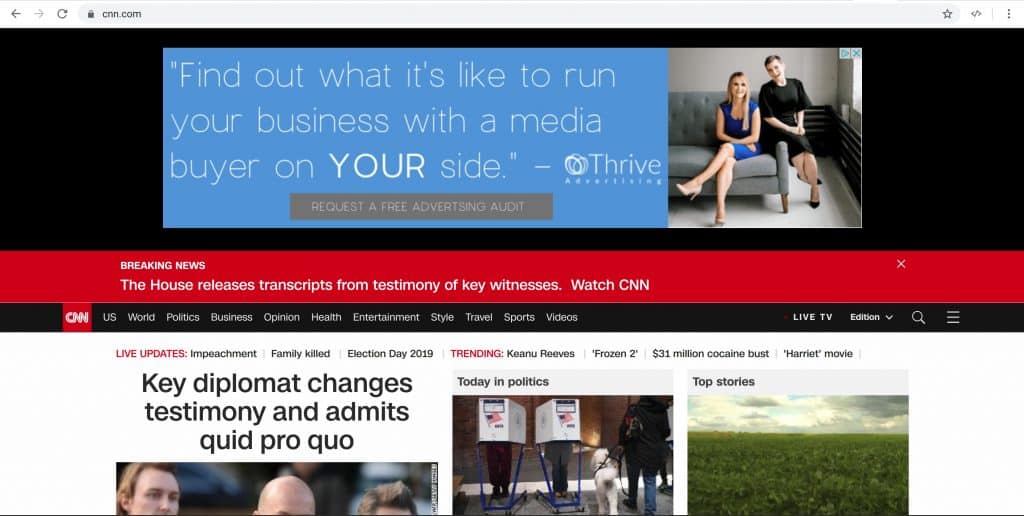Programmatic Marketing Agency might sound like industry jargon. Many of our customers were initially perplexed by the concept of programmatic advertising or were entirely unfamiliar with it before partnering with us. Programmatic marketing empowers you, the advertiser, to deliver personalized, always-on, and highly relevant ads to both current and potential customers. Leveraging artificial intelligence (AI), programmatic advertising technology serves ads to users who have visited your website and strategically targets users who share similarities with your existing customer base.
How does Programmatic Marketing work?
Programmatic advertising involves the placement of ads by platforms that engage in real-time bidding for advertising space. This process relies on target demographics and the prices advertisers are willing to pay for inventory. These platforms are known as “DSPs,” short for “Demand Side Platforms.” Serving as cutting-edge programmatic marketing systems, they provide advertisers with a streamlined and efficient means to access multiple ad exchanges and networks through a unified interface.
The History and Evolution of Digital Advertising to Programmatic Marketing
Over a decade ago, advertisers used to directly contact publishers to secure ad space on specific websites. For example, they would reach out to the NY Times and directly purchase ad slots on nytimes.com, employing a somewhat indiscriminate approach. The advertisers had to invest in a large volume of impressions, hoping that among those who saw the ads, some would be interested in their offerings.
Fast forward to the present, and the landscape has dramatically changed. Now, we have the capability to place ads across thousands of websites, focusing on specific demographics rather than individual sites. This targeted approach allows us to reach our desired audience wherever they are online, emphasizing demographics over particular websites. This strategy proves to be significantly more impactful compared to the traditional method of buying ads on a single website, relying on sheer numbers to connect with interested prospects.
What is a DSP in marketing? Defining the term “Demand Side Platform.”
DSPs are the driving force behind turning this vision into reality. DSP stands for Demand Side Platform, a technological marvel that swiftly analyzes millions of data points in seconds. Leveraging this wealth of data, a DSP engages in real-time bidding for ad space, ensuring your ads are promptly served to individuals more likely to be interested in your marketing, all at significantly reduced costs.
What does this translate to for marketers? It means incorporating a pixel on your website that fires immediately when someone lands on your site. If that visitor exits without taking the desired action (such as making a purchase or filling out a contact form), the DSP leaps into action. It instantaneously displays ads to that individual on the websites they subsequently visit. This ingenious mechanism enables marketers to re-engage with potential leads who didn’t convert initially and provides access to advertising space on prominent sites that might be financially impractical to acquire directly.

Programmatic Marketing is a significant advance for online advertising buyers
Programmatic Advertising swiftly grants buyers access to ad inventory from a vast array of publishers. This method has effectively supplanted the traditional approach where a media buyer would directly purchase ad space from a publisher. Shifting to a programmatic model not only lowers advertising costs but also ensures the delivery of higher-quality impressions to a more targeted and qualified audience.
Remarketing and Prospecting through Programmatic Marketing
Remarketing, sometimes referred to as Retargeting, encompasses the strategy mentioned earlier—displaying ads to customers who have previously visited your website. A pixel on your site triggers, initiating the DSP’s tracking of the visitor, and subsequently, serving them ads tailored to their website interactions. Remarketing achieves the dual purpose of keeping your brand at the forefront of their minds and delivering compelling Calls to Action, thereby boosting sales closures and enhancing your advertising return on investment (ROI).
On the other hand, Prospecting represents a distinct advertising tactic that utilizes the same pixel data accumulated from Remarketing endeavors. Unlike Remarketing, Prospecting focuses on acquiring new audiences based on behavioral data gathered from previous Remarketing efforts. By harnessing the power of Artificial Intelligence and Data, we can display ads to Look-alike prospects and precisely targeted users who share various characteristics with your current web visitors. This sophisticated approach enables us to broaden our reach and engage with audiences that exhibit traits similar to your existing customer base.
Want to go a step further? Layer in Big Data to your Programmatic Prospecting ad campaigns to really deliver results!

What is a Data Management Platform (DMP)? How can I use Big Data to improve my advertising campaign performance?
DMPs, short for Data Management Platforms, are sophisticated software systems and services designed to aggregate a wide array of data related to digital marketing activities. These platforms undertake a comprehensive process: starting with data analysis, moving on to targeting, verification, and ultimately utilizing data for refining marketing strategies. DMPs play a pivotal role as data aggregators, enabling Programmatic advertising to precisely target users based on their behavior and demographics. However, it’s the DMPs that often contribute to the “creepy factor” when ads seem remarkably tailored to your preferences and activities, appearing seamlessly in your feed or browser.
Ever felt like you’re being digitally shadowed by brands with unnervingly accurate ad personalization? DMPs leverage data such as income, credit information, profession, interests, demographics, psychographics, personal preferences, and beliefs to deliver ads to specific individuals. Thanks to DMPs and a Programmatic Marketing Agency, you’re now greeted with ads perfectly aligned with your interests. Did we mention that there are even health data segments for Prospecting? This means ads can be served to individuals with specific health conditions or those prescribed particular medications. Is this an invasion of privacy, or an incredibly valuable advertising tactic? The verdict is yours to decide. Nevertheless, this is the methodology employed by major brands, explaining why ads resonate so effectively in today’s digital landscape. And if you’re skeptical about your phone eavesdropping on you, check out our blog on whether your phone is really listening, and prepare to be either mind-blown or furious.
Programmatic Marketing Agency Example

In practical terms, let’s consider a scenario: You’re a Resort Marketer, and a visitor named Sarah lands on your website and books a Stay and Play Package with a Spa Credit.
Now, enter Programmatic Prospecting technology. We can now identify Look-alike users who exhibit similar online behaviors to Sarah and strategically display ads for your resort, gauging their interest in booking a vacation package. This process, known as Lookalike targeting serves ads to individuals with comparable income, taste, and demographics.
But let’s imagine Sarah didn’t complete the booking; instead, she merely added the Stay and Play Package to her cart and abandoned the cart before entering her credit card info. Enter Retargeting—a technique that serves her ads on the websites she visits over the next few days, gently reminding her of your resort’s offerings. Remarketing, as an advertising tactic, yields significant Return on Ad Spend (ROAS).
Now, for an even more sophisticated approach, the Resort Marketer could integrate 3rd party data through a Data Management Platform (DMP). This allows ads to be delivered to users similar to Sarah and those with a specific income level and an interest in skiing near your resort.
All these Programmatic Advertising tactics involve AI-assisted analysis of millions of data points. This analysis determines which users are more likely to be interested in your ads and offerings. Consequently, these strategies yield a more targeted ad campaign, providing a higher return on investment (ROI) at a significantly lower cost than buying ads directly from a content publisher.
More advanced targeting: Geofencing.
A Geofence, or “Geofencing,” represents a dynamic location-based digital marketing tool that allows us to engage smartphone users within or having visited a specific geographic area. The versatility of Geofencing extends to both real-time and historical data applications.
Now, here’s what makes this tool truly remarkable. Imagine showcasing an ad for the resort precisely when a guest is experiencing their stay, presenting the perfect opportunity for upselling into a more indulgent Spa Package. Yet, the true brilliance lies in harnessing historical data. Derived from Geofencing, this historical data becomes a strategic asset, particularly for sellers of high-value items. For instance, a resort community that also sells homes strategically establishes a Geofence around the resort. This savvy move enables them to later target guests who have previously stayed at the resort hotel with ads promoting vacation homes. Leveraging the positive past experience at the resort, this Geofencing marketing tactic delivers a significantly enhanced Return on Investment (ROI) compared to conventional banner ads.
Consider another impactful application—using Geofencing strategically against competitors. Picture yourself as a home developer deciding to Geofence the precise footprint of your rival’s development. The result? We can serve ads to any user who has visited that competing housing development within the past 12 months! The implications are profound and extend beyond home development to sectors like car dealerships and various other businesses aiming to gain a strategic edge in their marketing endeavors.
Cornell University’s Digital Marketing Program
Our aim is to demystify intricate advertising methods, presenting them in a clear and digestible manner.
Fun fact: Robin, the owner of Thrive Advertising, recently completed a series of Digital Marketing Courses at Cornell University, providing us with a unique connection to marketers nationwide. In her class, she engaged with professionals from Fortune 500 companies and Media Buyers from the leading Programmatic Marketing Agency in the U.S. What did she discover? Even the most seasoned marketers, considered the cream of the crop, find it challenging to stay abreast of the latest digital marketing tactics. The industry evolves rapidly, and that’s precisely why we place a significant emphasis on continuous education. Both Digital and Traditional advertising have undergone substantial transformations, and we’re committed to navigating these changes and keeping our strategies at the forefront of innovation.

We can be your secret business weapon. Your Programmatic Marketing Agency.
We’re honing our competitive edge to ensure you outshine the competition with the expertise of a seasoned media buyer by your side!
Media Buying is our daily playground—whether it’s traditional, digital, programmatic, or beyond, we’ve got you covered. Our proficiency lies in maximizing the impact of your advertising budget, and truth be told, many clients have hailed us as worth our weight in gold!
Business Owners and Marketing Managers appreciate that we handle the heavy lifting. Owners witness tangible improvements in their bottom line, while Managers bask in the glory of more recognition for doing less. It’s a win-win scenario, backed by compelling stories and testimonials that affirm our effectiveness.
Let us be your catalyst for making next year your most successful year yet! Want to delve into another perspective on Programmatic Display Advertising? Check out this article from Outbrain.
If you prefer a quick video explanation of Programmatic Marketing Agency, check out this video below.

